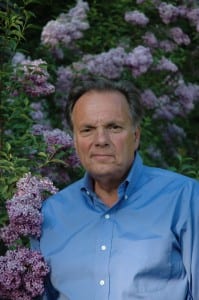 Ever smell a tomato plant? Dr. Carl Salsedo did, and it changed his life. He was three at the time, visiting a greenhouse in Thomaston with his father. One whiff of that singular scent launched a lifetime love affair with plants, gardening, and the interwoven mysteries of the natural world. At six, Salsedo had his own garden. By age 12, he was working at Bristol Nurseries, the world’s epicenter for modern mums. It’s been onward and upward since then.
Ever smell a tomato plant? Dr. Carl Salsedo did, and it changed his life. He was three at the time, visiting a greenhouse in Thomaston with his father. One whiff of that singular scent launched a lifetime love affair with plants, gardening, and the interwoven mysteries of the natural world. At six, Salsedo had his own garden. By age 12, he was working at Bristol Nurseries, the world’s epicenter for modern mums. It’s been onward and upward since then.
Not so long after he moved to his hilltop home in Burlington in 1977, he was gardening sustainably before it was even a recognized concept, exploring the warp and weft of nature’s networks. That meant, in the most simple terms, using mostly native plants while at the same time minimizing maintenance and inputs such as fertilizer, water, etc. One of the key elements was selecting plants adapted to his site and its varied microclimates. “The plants are all boilerplate,” he says. “Low maintenance, conifers, perennials and broadleaf stuff you can’t miss with. Easy.”
But just because it’s sustainable doesn’t mean it’s ugly. Salsedo’s garden has been open to visitors as part of the national Garden Conservancy’s Open Days Program for nearly a decade.
Sustainability means a lot of different things to a lot of different people, but Salsedo boiled the concept down to its essence by identifying what he believes are five basic tenets: development of a sustainable lawn (one that doesn’t rely on chemicals and nutritional additives and in which weeds are okay); use of native plants, not exclusively, but primarily; fostering a healthy environment; creating a biodiverse landscape, and practicing good ecology. “If you do one thing, recycle your leaves and your grass clippings,” he says. As much as 100 yards of fallen leaves are used as winter compost in Salsedo’s gardens.
It’s all about gardening with nature, which also happens to be the name of a CPTV series Salsedo hosted about a decade ago.
“What I advocate is stuff everybody can do,” he says. “It’s the democratization of the landscape.”
And Salsedo can do lots of advocating in his position as Extension Educator-Sustainable and Environmental Horticulture with UConn Extension. He is based in the Hartford County office and his responsibilities include developing sustainable landscaping programs and publications, and teaching the Fundamentals of Horticulture course at the West Hartford campus.
In addition, Salsedo completed a series for Connecticut Public Television entitled “Gardening with Nature,” that promoted sustainable practices within the suburban landscape. These vignettes are still broadcast throughout the year and the series has found a new home on the web and has been greatly expanded by Salsedo and Connecticut Public Television (available at www.cptv.org – keyword gardening).
Another of Salsedo’s most enduring research interests is exploring how people connect to nature through gardening and what makes us garden in the first place. He shared his findings in a book entitled “Gardening: Cultivating an Enduring Relationship with Nature” published in 2010.
Perhaps the seed of that interest was planted back when Salsedo was installing a swimming pool at his Burlington home. He hired a guy with an earth-moving excavator who, Salsedo says, happened to be a genius. Months later, Salsedo’s sloping hillside yard had been transformed into a staircase of terraced beds. The new topography just seemed to Salsedo a natural thing to do. He never wondered why. At least not until he visited his grandfather’s home on a tiny volcanic island not far from Sicily. There, all the land was terraced, the whole island. “So why did I terrace my hillsides?” he asks. Maybe it’s genetic.
And so too, there may be a genetic component to Salsedo’s desire to work in harmony with nature. If that’s the case, that desire may lie latent in all our genes, waiting to be rediscovered.
Originally published in the October 2013 issue of the Connecticut Horticultural Society newsletter.